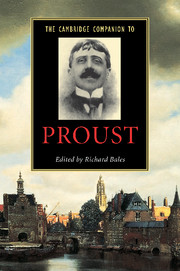Book contents
- Frontmatter
- Introduction
- 1 From Belle Epoque to First World War
- 2 The vast structure of recollection
- 3 Ruskin and the cathedral of lost souls
- 4 The birth and development of A la recherche du temps perdu
- 5 Lost and found: the structure of Proust’s novel
- 6 Proust’s Narrator
- 7 The unconscious
- 8 The texture of Proust’s novel
- 9 Proust’s human comedy
- 10 Proust and social spaces
- 11 Love, sexuality and friendship
- 12 Proust and the fine arts
- 13 Proust and posterity
- Postlude
- Select bibliography
- Index
5 - Lost and found: the structure of Proust’s novel
Published online by Cambridge University Press: 28 May 2006
- Frontmatter
- Introduction
- 1 From Belle Epoque to First World War
- 2 The vast structure of recollection
- 3 Ruskin and the cathedral of lost souls
- 4 The birth and development of A la recherche du temps perdu
- 5 Lost and found: the structure of Proust’s novel
- 6 Proust’s Narrator
- 7 The unconscious
- 8 The texture of Proust’s novel
- 9 Proust’s human comedy
- 10 Proust and social spaces
- 11 Love, sexuality and friendship
- 12 Proust and the fine arts
- 13 Proust and posterity
- Postlude
- Select bibliography
- Index
Summary
Near the middle of 'Combray', the opening section of Proust's Search, the Narrator describes the exceptional after-dinner walks the Protagonist and his parents used to take on beautiful May evenings. His father would lead them far out into the countryside as darkness was falling and then suddenly ask, 'Where are we?' (I, 113; I, 136/160). After his mother invariably acknowledged that she was utterly lost, her amused husband would point out that they were standing right in front of their lower garden gate: by a gently circuitous route, he had led them home in the dark. 'You're extraordinary!' the wife would exclaim admiringly. The Protagonist would stand silent, attentive to how the forbidding world of unfamiliar shadows around him was now transforming itself under his feet into the welcoming garden of his childhood.
No novelist could compose such an incident of getting lost and finding one’s way again without thinking about how to tell a story and its effect on the reader. In this case, the father’s surefooted navigation stands for Proust’s confidence about the direction and outcome of his story. ‘You may think you’ve lost your way in my narrative, but I know exactly where I’m taking you.’ We are, of course, still close to the opening.
- Type
- Chapter
- Information
- The Cambridge Companion to Proust , pp. 74 - 84Publisher: Cambridge University PressPrint publication year: 2001
- 3
- Cited by



